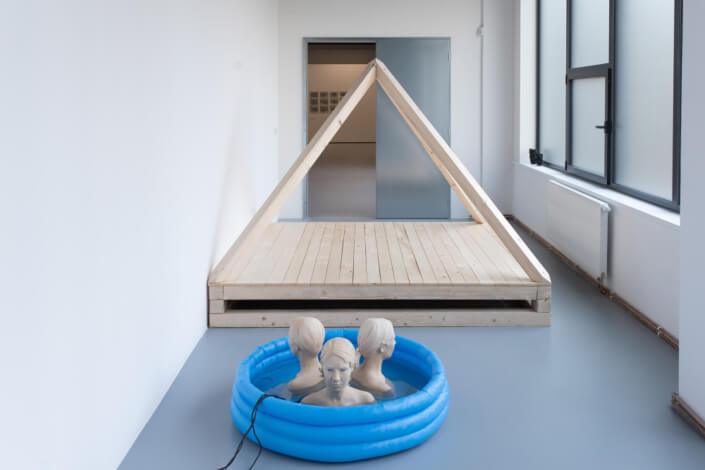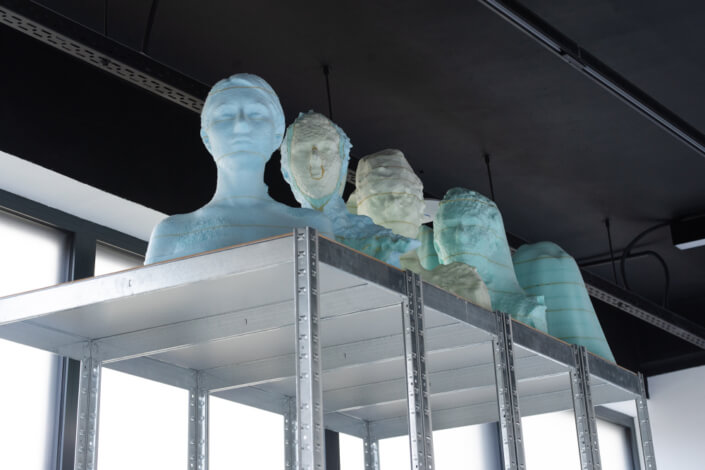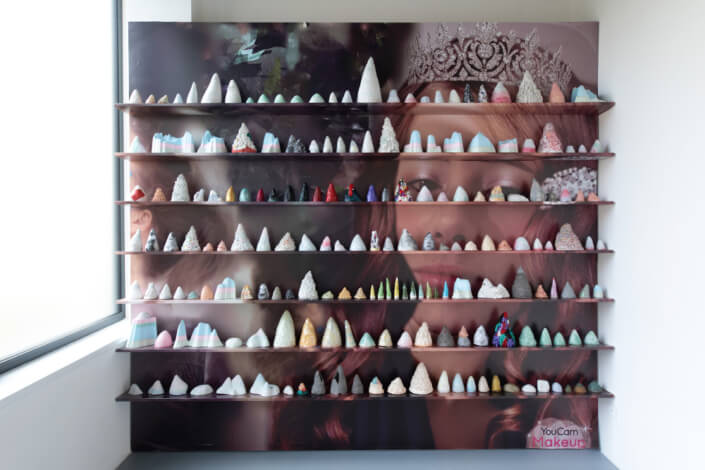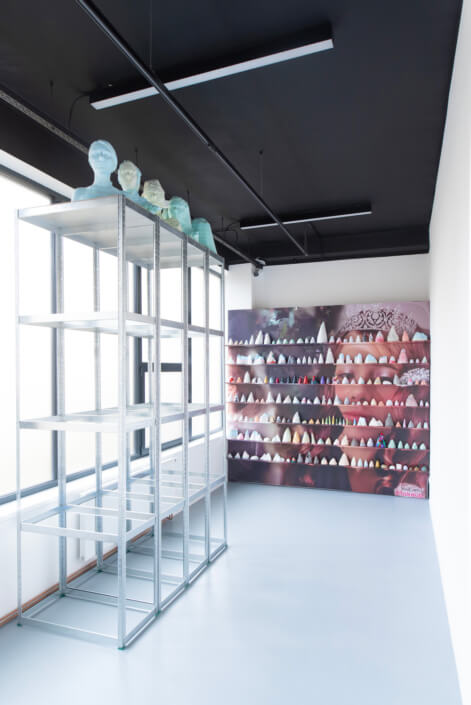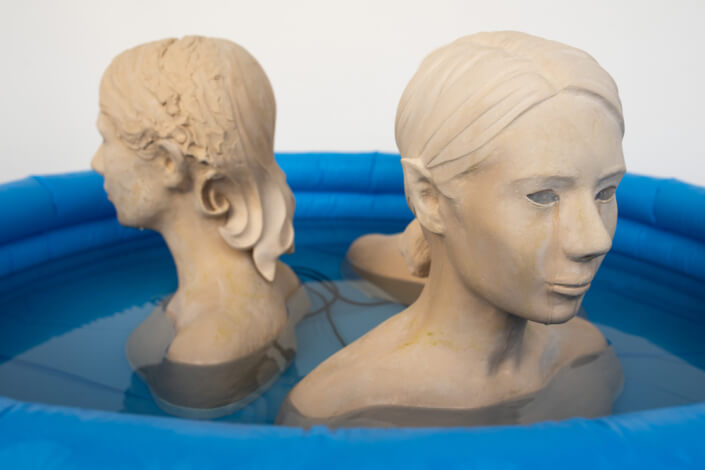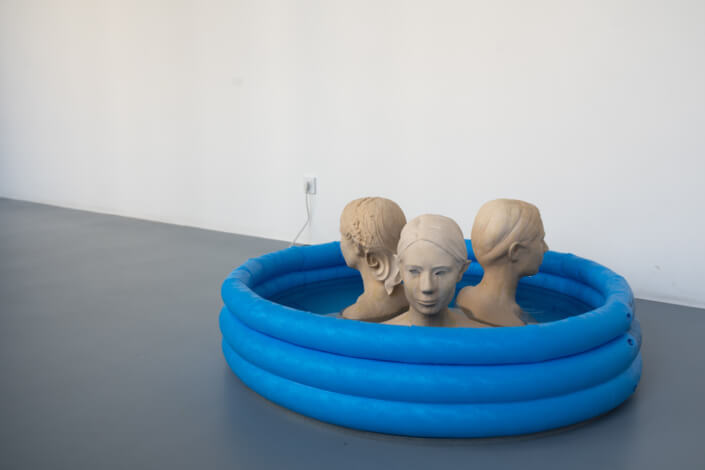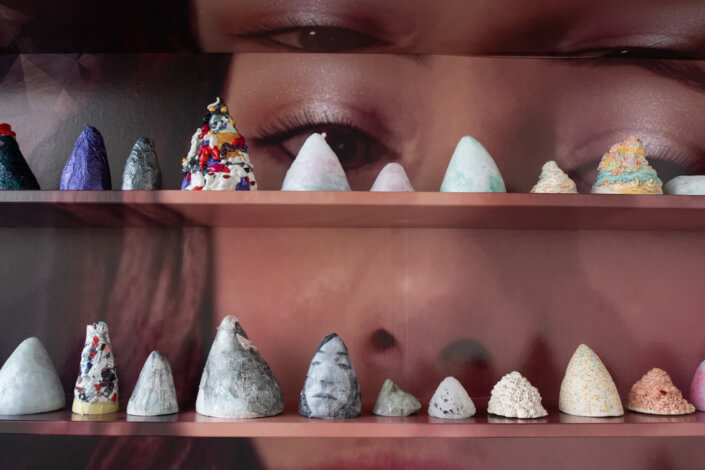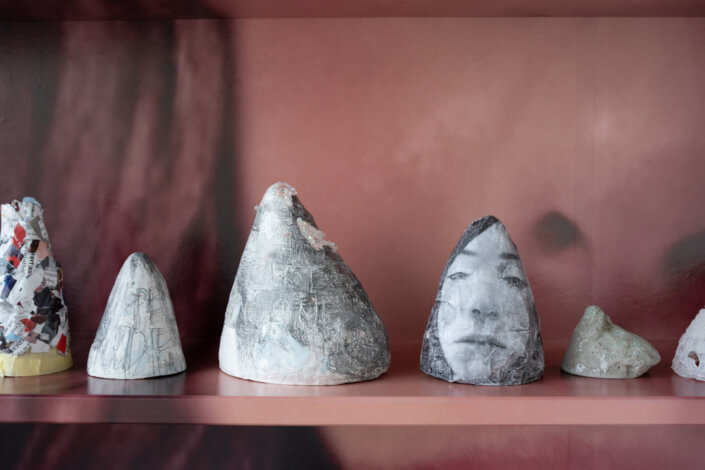Selfdesign: Chapter II – Once upon the Time
To realize emptiness and lowliness. To free oneself from big ideas. To come to terms with mortality and extinction as one of the most natural principles of the world. Transience, nothingness, futility, and vanity are the basic themes that Ľubica Mildeová deals with in her work represented in the exhibition Self-Design: Chapter II-Once Upon a Time… These themes are represented by several self-portraits, which sounds rather unflattering – nothingness and vanity represented by oneself. But artists had already begun to take a bold interest in this subject during the Renaissance – Albrecht Dürer produced several self-portraits during his lifetime, beginning with a drawing of a tender face he made at the age of thirteen. The most complex, however, is considered to be the Self-Portrait in a Fur Coat, in which he captured himself in a deified stylization in the likeness of Christ. On the one hand, the artist undergoes apotheosis in the hope of avoiding extinction and yet surviving forever through his work (Dürer succeeds for five centuries); on the other hand, he is aware of his mortality and sinfulness. This is most evident in his painting of Vanitas, a lasciviously smiling old woman who bears the features of Dürer’s face. In contrast to the vanity evident in Dürer’s self-portraits, a hundred and fifty years later another master–Rembrandt van Rijn–treats only vanity, especially towards the end of his life. His likenesses are more conciliatory. However, he also dealt with vanity in the depictions so common in his time–still lifes with skulls, hourglasses, wilting flowers, rotting fruit, musical instruments, and cards. Self-portraiture was also a major influence on contemporary art theory–one of the foundational essays in the critical theory of Representation, Appropriation, and Power is based on an interpretation of Velázquez’s likeness captured through the gaze of the royal couple in the painting Las Meninas.
However, with the development of reproducible images and other technologies, the extent and availability of self(re) presentations are changing. Not only in virtual but also in real space, the crisis of identity and the human ability to grasp the integrity of being is deepening, and above all, it leads to a crisis of one’s responsibility to and for the world, and a loss of responsibility to and for oneself. To better understand the reason for this statement, let me use the opening passage of Havel’s important essay, in which he reflects precisely on the crisis of identity: ‚I realised recently, during a television report from a cowshed, that the cow is no longer an animal: it is a machine that has its ‚inputs‘ /nuclear feed/ and its ‚outputs‘ /milk/, that has its production plan and its engineer […] man has seized the world in such a way that he has de facto lost it; he has conquered it in such a way that he has destroyed it…“ This example could be allegorically transferred to the virtual space carefully managed and cherished by many. But in it, we become the inputs, outputs, the manager of the production plan, and the engineer. We become the products. One of the most characteristic proofs is the personalized videos you can order on demand from your favorite celebrity. From the attention economy, the desire for perfect self-design and its recognition is moving into the market sphere, and for $690 you can hear a message from, say, Brian Cox, who will refer you to that your absence is required, Chris Noth (The Perfect Man from Sex and the City – OMG), or for a much lower amount, tennis player Petra Januskova (she looks pretty in the promo video, but doesn’t talk) will send you a message.
With the current rise and development of social networks, the user is overwhelmed by this communication strategy. The solid body dissolves into individual bits and folds into a shallow, useless, and vulgar visual garden full of weeds that grow and grow through screens into our most intimate spaces. Ľubica reacts critically to the phenomenon of transformation from subject to object in her work, for example, by misusing technologies – filters commonly used for image enhancement, or on the contrary, by modifying and degrading input data – selfies to create bust/landscape-shaped objects using photogrammetry techniques and then milling them into extruded polystyrene with a CNC milling machine.
The theory of the young girl – symmetrical face, big eyes, beautiful hair, full lips – is undeniably connected with Ľubica Mildeová’s work. Society forces her/him into a state of being a commodity. Although the „girl“ longs to be happy, successful, and admired, and presents herself as such in real and virtual society, in reality, she is both a symbol and an object of an „invisible“ but all the more terrifying total war, where the object of conflict is the way of controlling the forms of life in a developed consumer society. Ľubica is aware of this conflict: the realistically crafted ceramic busts in the central part of the exhibition lament the state of this existence. With this new work, the artist also expands and develops the theme of her dissertation – the cult of intimacy. After all, what could be more intimate than giving oneself away and presenting oneself as a being who is afraid, tormented, and in pain?
An important phenomenon linking self-design and the cult of intimacy is represented in the exhibition by the crypto-portrait. In the artist’s conception, it is an intimate, personal space represented by handmade objects symbolizing hills or mountains, but to some extent also the phallus. For Ľubica Mildeová, the principles of the apotheosis of the artist in the sense of a deity who designed the world are again important in this work. The artist began to explore this approach during a study stay in Belgrade, where she used a standard elementary sculpture-modeling principle – the lost form. Gradually, however, the technique and material expanded. In the series Personal Landscapes we see, alongside plaster objects, objects made of glazed and natural ceramics, papier-mâché, and silicone hills covered with acrylic paints, appliqué, clever plasticine, and other artistic means. Each of them conveys to us a message of individuality. At the same time, it is important to notice the whole, on which we can trace the artist’s „personal landscape“, but also the principles, which again relate to design practice. Ľubica explores the mutations between sculpture and design evidenced by the aestheticized decorative pompous appearance and the accumulation of „products“, which again refers to her interest in the principles of market and consumption.
The overall installation includes a wooden pyramid, in contrast to the exalted cycles of self-portraits, offering the possibility of emptiness and contemplation. But in an empty and would-be zen point, can we free ourselves from the overwrought artifacts and the vision of the weeping girl? And do we rather feel sorry for her, or do we feel satisfaction at a pain that may be greater than our own?
But lest we succumb only to a one-sided nihilistic view of the state of identity and intimacy with changing and expanding new types of communication and thinking about the self, I will mention a few notes from current research. Digital anthropologist Marie Heřmanová from the Institute of Sociology of the CAS refutes the above-mentioned entropic view. According to her, social networks are not a demonic means that deprives us of free will and we are completely powerless against it. She is speaking out against the brutal technological determinism that distorts our attention, polarizes society, and distracts people from their responsibility towards themselves. It defines social networks as a tool that we must approach responsibly and in a meaningful relationship with our environment. Ľubica Mildeová is responsible for her relationship with herself and the world. Precisely by drawing attention to these social and ontological phenomena through her artistic work.
The realization was supported by the Fond na podporu umenia.
Photo: Filip Trubač
Self-Design: Chapter II–Once Upon the Time…
Ľubica Mildeová
Galerie 2, Dům umění Ústí nad Labem
3. 3. – 7. 4. 2022
Curator: Barbora Hájková
It’s your faith you will be dead as the God
• Vepříček Johny Chaos1
Vanitas vanitatum et omnia vanitas
• Kniha Kazatel

